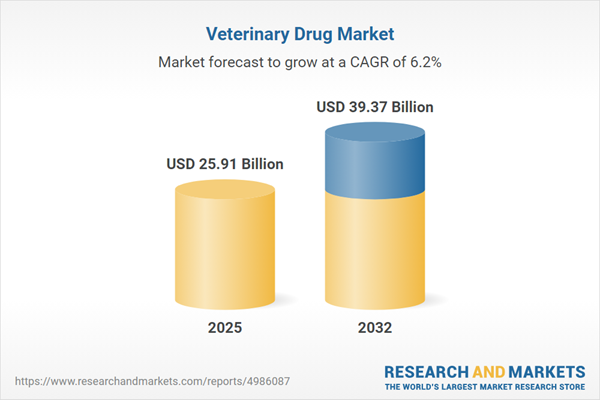Speak directly to the analyst to clarify any post sales queries you may have.
The veterinary drug market is rapidly transforming as industry leaders navigate complex health demands and evolving regulatory priorities. Optimized innovation, resilient supply chains, and next-generation therapeutics are shaping a sophisticated landscape for veterinary pharmaceutical decision-makers.
Market Snapshot: Veterinary Drug Market Growth and Resilience
The Veterinary Drug Market grew from USD 24.39 billion in 2024 to USD 25.91 billion in 2025. It is expected to continue growing at a CAGR of 6.16%, reaching USD 39.37 billion by 2032. This steady upward trajectory reflects consistent investment and the industry’s critical role in supporting global animal health, particularly in the face of heightened disease threats, precision medicine, and changing consumer expectations. As pharmaceutical innovation aligns with animal welfare and sustainability, the sector remains positioned for robust expansion and operational agility.
Scope & Segmentation: Comprehensive Market Coverage
This report analyzes the full spectrum of the veterinary drug sector, identifying the most influential market drivers and actionable opportunities for senior executives:
- Product Categories: Anti-infectives (including antibiotics such as cephalosporins, fluoroquinolones, macrolides, penicillins, tetracyclines; antifungals; antivirals), anti-inflammatories, parasiticides, and vaccines.
- Routes of Administration: Inhalation, injectable, oral, topical.
- Animal Types: Aquaculture (fish, shrimp), companion animals (canines, felines), equine, livestock (cattle, small ruminants, swine), poultry (chickens, turkeys).
- Distribution Channels: Online pharmacies, retail pharmacies, veterinary hospitals.
- Regional Analysis: Americas (North America: United States, Canada, Mexico; Latin America: Brazil, Argentina, Chile, Colombia, Peru), Europe, Middle East & Africa (Western and Eastern Europe, Middle East, Africa), Asia-Pacific (China, India, Japan, Australia, South Korea, Indonesia, Thailand, Malaysia, Singapore, Taiwan).
- Company Coverage: Zoetis Inc., Elanco Animal Health Incorporated, Merck & Co., Inc., Boehringer Ingelheim International GmbH, Ceva Santé Animale S.A., Virbac S.A., Phibro Animal Health Corporation, Dechra Pharmaceuticals PLC, Vetoquinol S.A., Norbrook Laboratories Limited.
The scope also considers digital technologies such as telemedicine and AI-driven analytics, as well as the strategic interplay between regulatory policy and supply chain evolution within the veterinary sector.
Key Takeaways for Industry Leaders
- Accelerated innovation is driven by cross-sector collaborations, including joint ventures between technology firms, research institutions, and contract development organizations.
- Digital integration through telemedicine and analytics platforms is advancing rapid healthcare delivery and optimizing supply chain performance.
- One Health initiatives are gaining traction, emphasizing unified approaches to antimicrobial stewardship and sustainable disease management for humans, animals, and the environment.
- Formulation and delivery innovation, including targeted routes of administration, addresses disease complexity and varying animal physiologies.
- Strategic alliances and digital service enhancements such as telemedicine subscriptions are transforming traditional market engagement and customer retention models.
- Emerging regions are shaping new demand patterns as regulatory harmonization and enhanced veterinary infrastructure create fresh opportunities for manufacturing and product adoption.
Tariff Impact and Supply Chain Adaptation
Recent United States tariff changes are adding complexity to the procurement and manufacturing landscape for veterinary drugs. Companies are adjusting sourcing strategies and ramping up domestic and alternative supply networks to mitigate increased costs of imported active ingredients. These initiatives are further supported by process innovations and ongoing policy incentives designed to reinforce local pharmaceutical infrastructure.
Robust Methodology & Data Sources
Analysis is built on structured primary interviews with pharmaceutical executives, researchers, and regulatory authorities, combined with comprehensive secondary desk research. Multilayered triangulation of proprietary data, regulatory filings, and expert insights ensures the highest standards of accuracy and reliability.
Why This Report Matters
- Enables executives to make informed decisions backed by rigorous, up-to-date market intelligence and strategic segmentation insights.
- Highlights actionable pathways for leveraging digital health, sustainable practices, and cross-sector partnerships in a rapidly evolving market.
Conclusion
The veterinary drug sector’s future hinges on technological integration, adaptive supply chains, and compliance excellence. Strategic investments and collaborative innovations will empower organizations to realize value and deliver effective solutions to a changing animal health landscape.
Additional Product Information:
- Purchase of this report includes 1 year online access with quarterly updates.
- This report can be updated on request. Please contact our Customer Experience team using the Ask a Question widget on our website.
Table of Contents
3. Executive Summary
4. Market Overview
7. Cumulative Impact of Artificial Intelligence 2025
Companies Mentioned
The companies profiled in this Veterinary Drug market report include:- Zoetis Inc.
- Elanco Animal Health Incorporated
- Merck & Co., Inc.
- Boehringer Ingelheim International GmbH
- Ceva Santé Animale S.A.
- Virbac S.A.
- Phibro Animal Health Corporation
- Dechra Pharmaceuticals PLC
- Vetoquinol S.A.
- Norbrook Laboratories Limited
Table Information
| Report Attribute | Details |
|---|---|
| No. of Pages | 181 |
| Published | October 2025 |
| Forecast Period | 2025 - 2032 |
| Estimated Market Value ( USD | $ 25.91 Billion |
| Forecasted Market Value ( USD | $ 39.37 Billion |
| Compound Annual Growth Rate | 6.1% |
| Regions Covered | Global |
| No. of Companies Mentioned | 11 |









